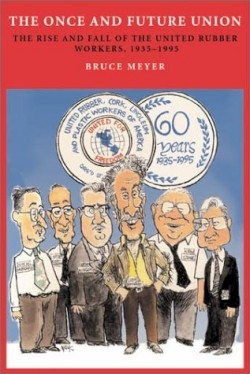The Once and Future Union
The Rise and Fall of the United Rubber Workers, 1935-1995
“If the union workers were not battling a tire or rubber company at the bargaining table or on the picket lines, they were fighting with each other,” writes the author in this sixty-year history of the Akron, Ohio-based United Rubber Workers union. After efforts to unionize rubber industry employees had dragged on for decades, the union was formed in 1935.
A year later, the union went on strike at the Goodyear plant and all of the company’s operations in Akron came to a halt. Union workers surrounded the whole eleven-mile perimeter of the complex, the longest picket line in United States history.
As a result, hourly employees joined the union there, bringing the total number of union members to more than 10,000, from an initial total of 600. Meyer, who is managing editor of Rubber & Plastics News (published by Crain Communications) and who interviewed current and former members of the URW, recounts the union’s strikes in other cities. In a violent clash in 1936 in Gadsden, Alabama, the union president was beaten by a mob. Meyer describes sit-down protests, beatings of non-union workers, murder threats, and acts of intimidation, including a bombing by union militants.
“The pendulum of power clearly now leaned toward labor, with management powerless to act against even the most despicable of acts,” Meyer writes. Chronicling the URW’s difficulties with Goodyear because of the company’s continued resistance to the union, he writes that during World War II the union grew; companies were forced to sign union contracts or risk losing lucrative government business. By December 1941, the union boasted 93,000 members—63 percent of all rubber workers—and by 1944 the number had risen to 182,000.
Meyer traces the presidency of the union’s six leaders (accounting for a large part of the book), recounts later strikes, and writes of the union’s eventual merger with the larger United Steelworkers of America in 1995 after some plant closings and consolidations.
Meyer’s account of the union’s battles and conventions, the strikes and organizational campaigns, its intrepid rise and inevitable fall—“a saga of conflict,” he calls it—is the eighteenth book in the Ohio History and Culture Series. The author has taken what could have been an indifferent subject and made it riveting.
Disclosure: This article is not an endorsement, but a review. The publisher of this book provided free copies of the book to have their book reviewed by a professional reviewer. No fee was paid by the publisher for this review. Foreword Reviews only recommends books that we love. Foreword Magazine, Inc. is disclosing this in accordance with the Federal Trade Commission’s 16 CFR, Part 255.

